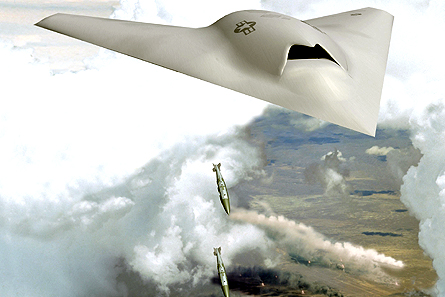Development expected to start in 2008 as service studies next-generation options
The US Air Force has set aside $2 billion over the next several years to launch the accelerated development of a next-generation bomber that is almost certain to be unmanned and unlike anything on the ramp today. At the same time, the air force continues to evaluate manned vehicle technologies, such as a hypersonic spaceplane, that could be technologically feasible about a decade after the unmanned bomber is due to enter service in 2018.
Air force officials are confident full-scale development of an unmanned vehicle can start from 2008-10. The plan is to accelerate air vehicle technologies under development for the Joint Unmanned Combat Air Systems programme, but the Boeing X-45C and Northrop Grumman X-47B designs are considered inadequate for the new bomber requirement.
|
| Boeing's X-45 is deemed inadequate for the new strike concept |
For propulsion, the air force is considering new engine concepts with variable cycles that can be efficient in subsonic and supersonic flight, says Gen Bruce Carlson, chief of Air Force Material Command, who briefed reporters at the Air Force Association Air Warfare Symposium in Orlando, Florida.
The unmanned vehicle would augment the USAF’s manned Boeing B-52, Northrop B-2 and Rockwell B-1 bombers, which are expected to remain in active service well beyond 2020. Last year, the air force flirted with a proposal for a manned regional bomber based on Lockheed Martin’s FB-22 concept, but this has been discarded (Flight International, 4-10 January 2005).
The new requirements for a long-range strike capability demand a stealthy platform offering long endurance and greater weapons capacity than any manned aircraft can provide, says Gen Ronald Keys, commander of Air Combat Command, which leads the requirements definition for the capability.
An air force development plan and acquisition strategy is expected to be ready to enter the Pentagon’s review process after about one year, says Carlson.
Another option, although remote, may be to scratch the unmanned bomber concept and develop a more accurate, conventional warhead that can be launched ballistically and reach anywhere in the world within minutes or hours. However, the Prompt Global Strike (PGS) option is marred by “political baggage” over concerns about the weaponisation of such launch vehicles, which have traditionally been used for nuclear warheads. But Keys does not view the PGS concept as a direct competitor to the unmanned bomber concept.
STEPHEN TRIMBLE / ORLANDO
Source: Flight International
























